Theories, Models, and Principles in Education and Training Report
VerifiedAdded on 2023/01/20
|27
|7425
|80
Report
AI Summary
This report delves into the core principles of education and training, exploring various learning theories, models, and their practical applications. It examines behaviorism, cognitivism, and constructivism, along with motivational and integrated learning models. The report analyzes communication theories, assessment methodologies, curriculum development, and reflective practices. It also discusses the Honey and Mumford and VARK models of learning preferences, emphasizing their impact on inclusive teaching and assessment strategies. The report aims to provide educators with insights into effective teaching strategies and assessment techniques for fostering a comprehensive and inclusive learning environment.
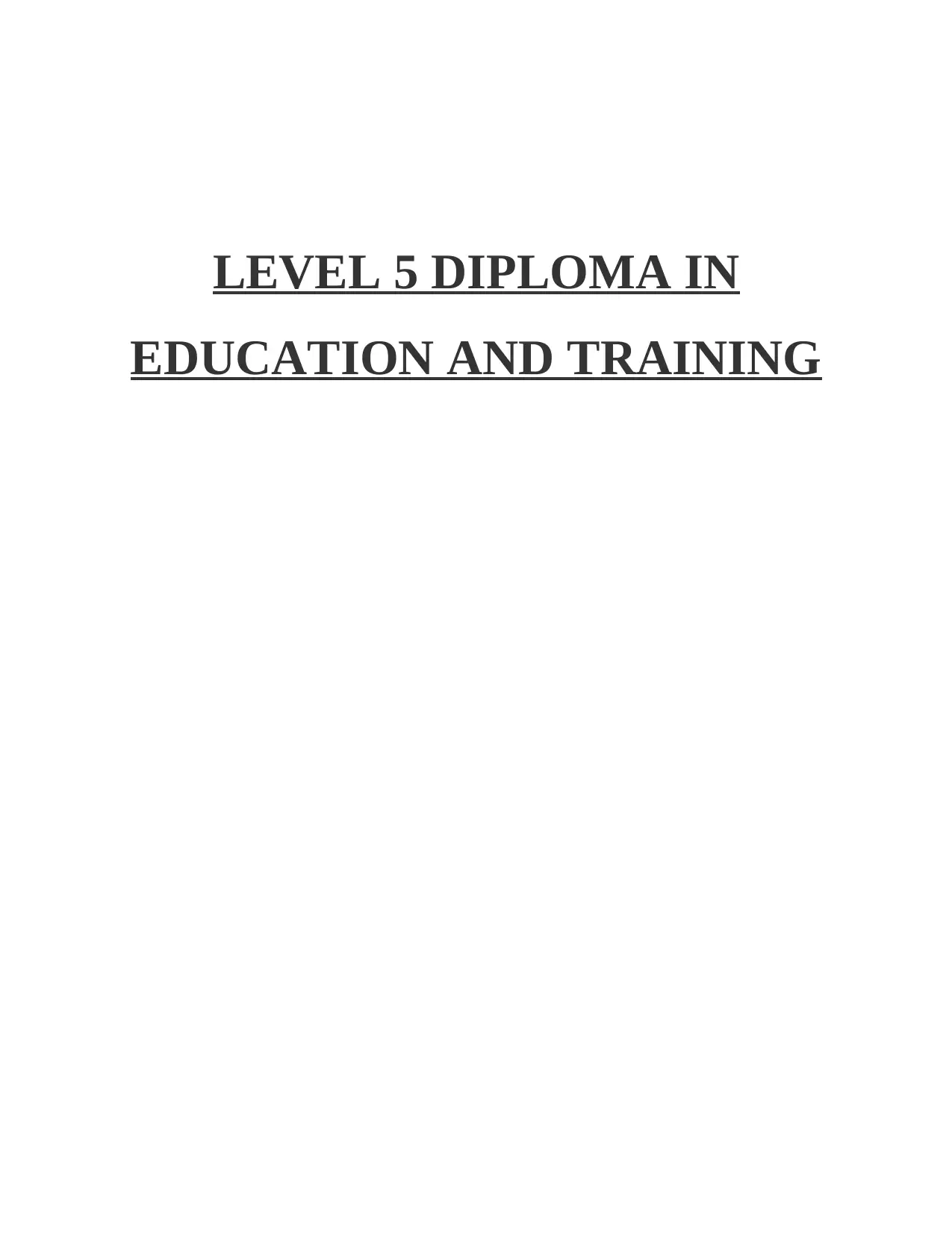
LEVEL 5 DIPLOMA IN
EDUCATION AND TRAINING
EDUCATION AND TRAINING
Paraphrase This Document
Need a fresh take? Get an instant paraphrase of this document with our AI Paraphraser
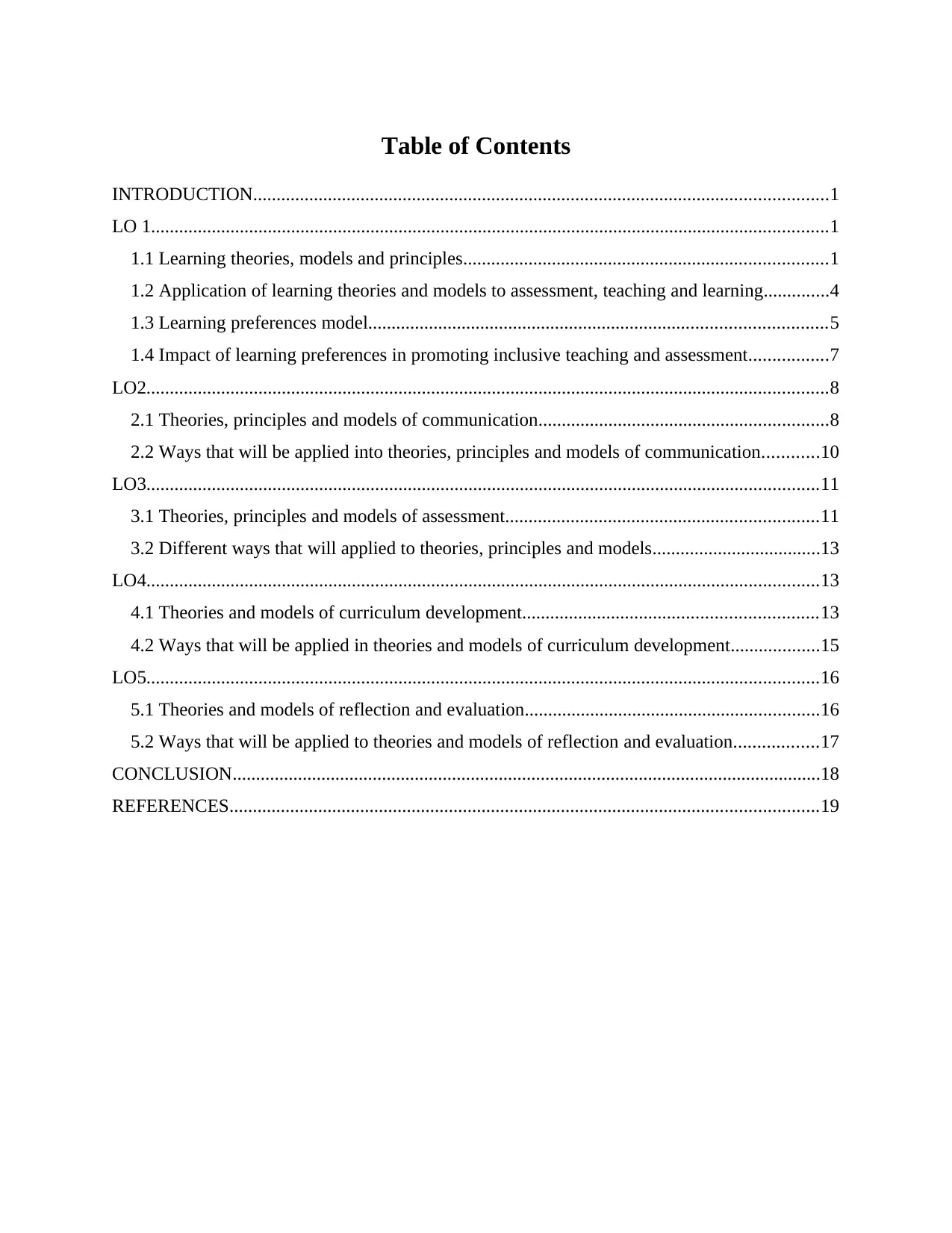
Table of Contents
INTRODUCTION...........................................................................................................................1
LO 1.................................................................................................................................................1
1.1 Learning theories, models and principles..............................................................................1
1.2 Application of learning theories and models to assessment, teaching and learning..............4
1.3 Learning preferences model..................................................................................................5
1.4 Impact of learning preferences in promoting inclusive teaching and assessment.................7
LO2..................................................................................................................................................8
2.1 Theories, principles and models of communication..............................................................8
2.2 Ways that will be applied into theories, principles and models of communication............10
LO3................................................................................................................................................11
3.1 Theories, principles and models of assessment...................................................................11
3.2 Different ways that will applied to theories, principles and models....................................13
LO4................................................................................................................................................13
4.1 Theories and models of curriculum development...............................................................13
4.2 Ways that will be applied in theories and models of curriculum development...................15
LO5................................................................................................................................................16
5.1 Theories and models of reflection and evaluation...............................................................16
5.2 Ways that will be applied to theories and models of reflection and evaluation..................17
CONCLUSION..............................................................................................................................18
REFERENCES..............................................................................................................................19
INTRODUCTION...........................................................................................................................1
LO 1.................................................................................................................................................1
1.1 Learning theories, models and principles..............................................................................1
1.2 Application of learning theories and models to assessment, teaching and learning..............4
1.3 Learning preferences model..................................................................................................5
1.4 Impact of learning preferences in promoting inclusive teaching and assessment.................7
LO2..................................................................................................................................................8
2.1 Theories, principles and models of communication..............................................................8
2.2 Ways that will be applied into theories, principles and models of communication............10
LO3................................................................................................................................................11
3.1 Theories, principles and models of assessment...................................................................11
3.2 Different ways that will applied to theories, principles and models....................................13
LO4................................................................................................................................................13
4.1 Theories and models of curriculum development...............................................................13
4.2 Ways that will be applied in theories and models of curriculum development...................15
LO5................................................................................................................................................16
5.1 Theories and models of reflection and evaluation...............................................................16
5.2 Ways that will be applied to theories and models of reflection and evaluation..................17
CONCLUSION..............................................................................................................................18
REFERENCES..............................................................................................................................19
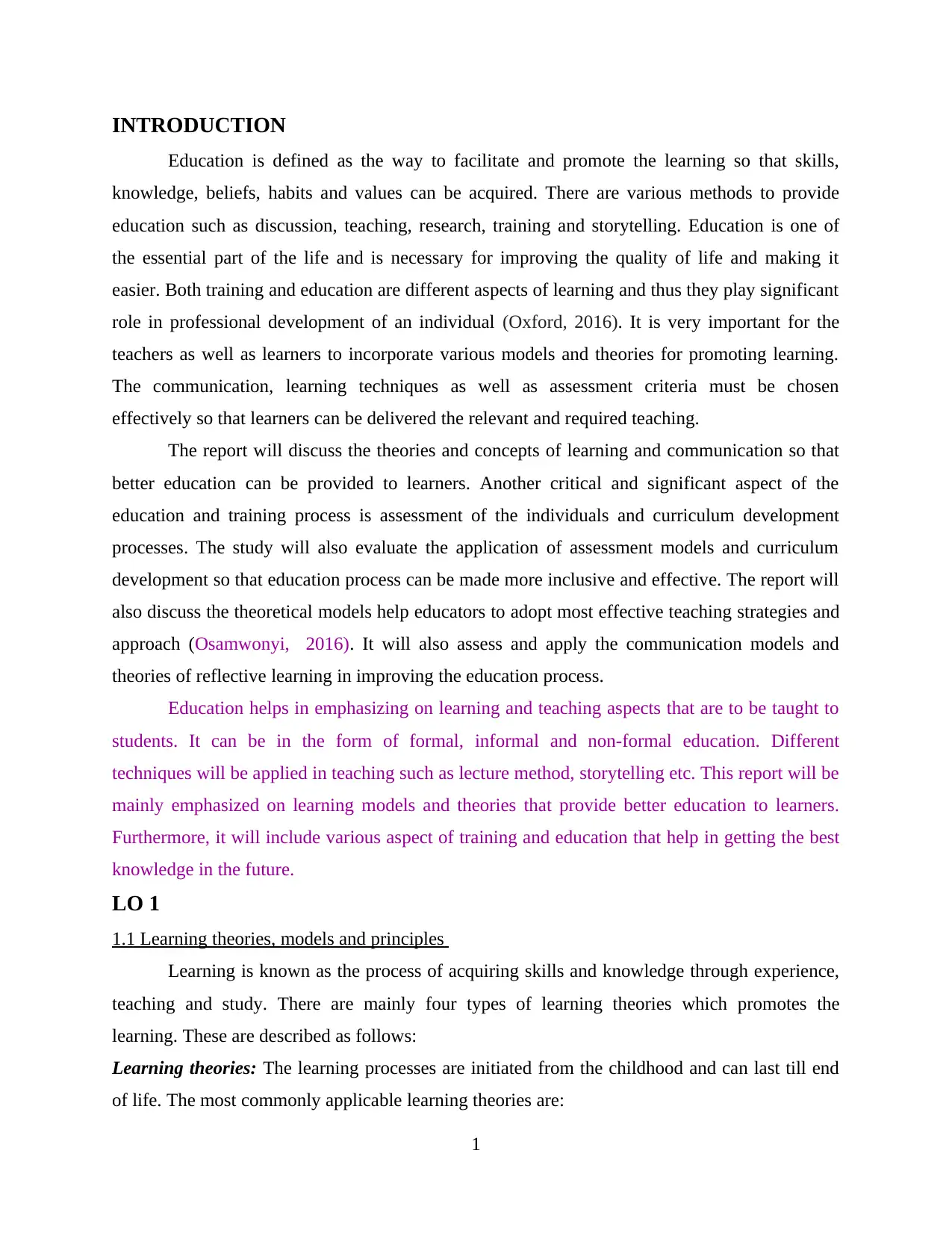
INTRODUCTION
Education is defined as the way to facilitate and promote the learning so that skills,
knowledge, beliefs, habits and values can be acquired. There are various methods to provide
education such as discussion, teaching, research, training and storytelling. Education is one of
the essential part of the life and is necessary for improving the quality of life and making it
easier. Both training and education are different aspects of learning and thus they play significant
role in professional development of an individual (Oxford, 2016). It is very important for the
teachers as well as learners to incorporate various models and theories for promoting learning.
The communication, learning techniques as well as assessment criteria must be chosen
effectively so that learners can be delivered the relevant and required teaching.
The report will discuss the theories and concepts of learning and communication so that
better education can be provided to learners. Another critical and significant aspect of the
education and training process is assessment of the individuals and curriculum development
processes. The study will also evaluate the application of assessment models and curriculum
development so that education process can be made more inclusive and effective. The report will
also discuss the theoretical models help educators to adopt most effective teaching strategies and
approach (Osamwonyi, 2016). It will also assess and apply the communication models and
theories of reflective learning in improving the education process.
Education helps in emphasizing on learning and teaching aspects that are to be taught to
students. It can be in the form of formal, informal and non-formal education. Different
techniques will be applied in teaching such as lecture method, storytelling etc. This report will be
mainly emphasized on learning models and theories that provide better education to learners.
Furthermore, it will include various aspect of training and education that help in getting the best
knowledge in the future.
LO 1
1.1 Learning theories, models and principles
Learning is known as the process of acquiring skills and knowledge through experience,
teaching and study. There are mainly four types of learning theories which promotes the
learning. These are described as follows:
Learning theories: The learning processes are initiated from the childhood and can last till end
of life. The most commonly applicable learning theories are:
1
Education is defined as the way to facilitate and promote the learning so that skills,
knowledge, beliefs, habits and values can be acquired. There are various methods to provide
education such as discussion, teaching, research, training and storytelling. Education is one of
the essential part of the life and is necessary for improving the quality of life and making it
easier. Both training and education are different aspects of learning and thus they play significant
role in professional development of an individual (Oxford, 2016). It is very important for the
teachers as well as learners to incorporate various models and theories for promoting learning.
The communication, learning techniques as well as assessment criteria must be chosen
effectively so that learners can be delivered the relevant and required teaching.
The report will discuss the theories and concepts of learning and communication so that
better education can be provided to learners. Another critical and significant aspect of the
education and training process is assessment of the individuals and curriculum development
processes. The study will also evaluate the application of assessment models and curriculum
development so that education process can be made more inclusive and effective. The report will
also discuss the theoretical models help educators to adopt most effective teaching strategies and
approach (Osamwonyi, 2016). It will also assess and apply the communication models and
theories of reflective learning in improving the education process.
Education helps in emphasizing on learning and teaching aspects that are to be taught to
students. It can be in the form of formal, informal and non-formal education. Different
techniques will be applied in teaching such as lecture method, storytelling etc. This report will be
mainly emphasized on learning models and theories that provide better education to learners.
Furthermore, it will include various aspect of training and education that help in getting the best
knowledge in the future.
LO 1
1.1 Learning theories, models and principles
Learning is known as the process of acquiring skills and knowledge through experience,
teaching and study. There are mainly four types of learning theories which promotes the
learning. These are described as follows:
Learning theories: The learning processes are initiated from the childhood and can last till end
of life. The most commonly applicable learning theories are:
1
⊘ This is a preview!⊘
Do you want full access?
Subscribe today to unlock all pages.

Trusted by 1+ million students worldwide
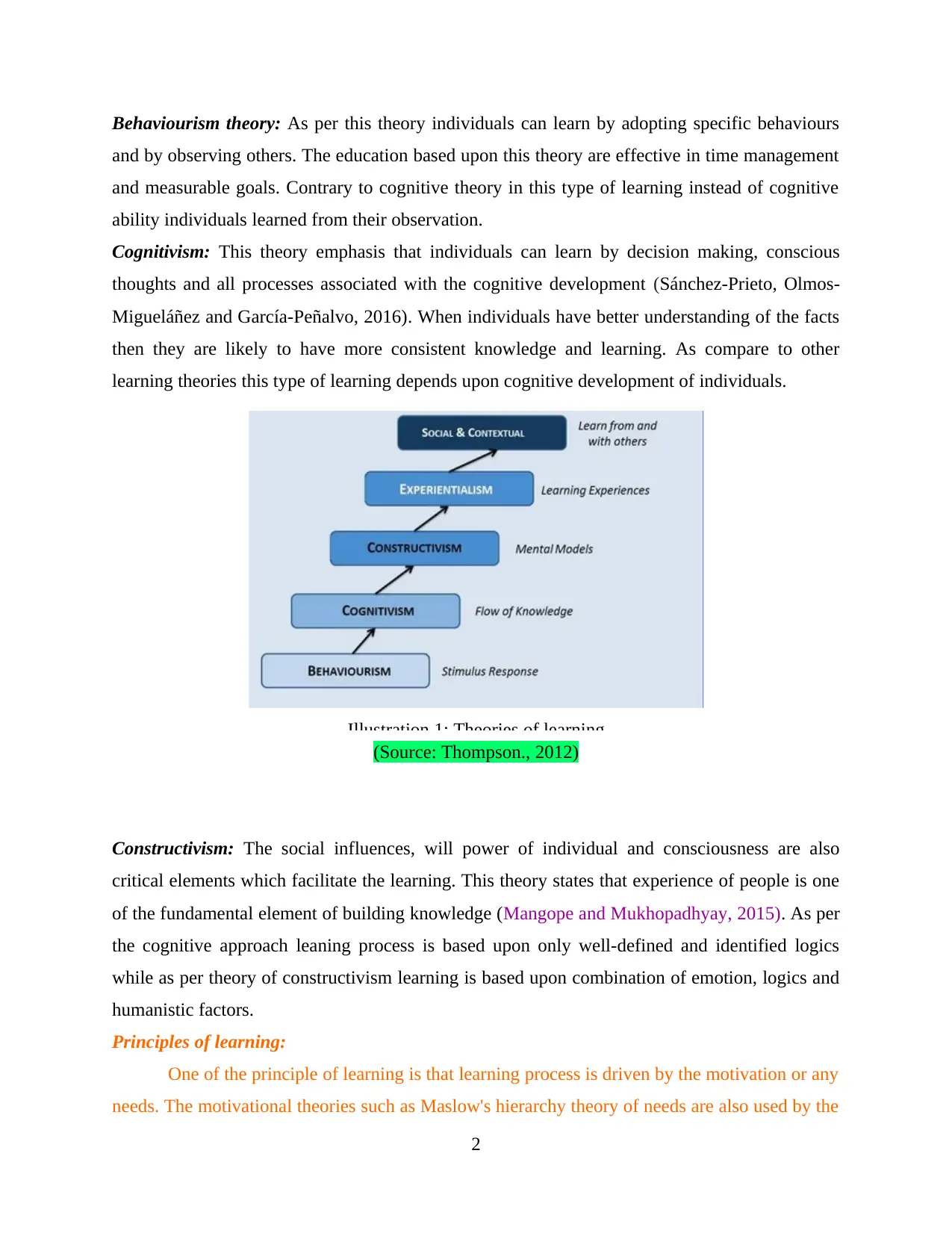
Behaviourism theory: As per this theory individuals can learn by adopting specific behaviours
and by observing others. The education based upon this theory are effective in time management
and measurable goals. Contrary to cognitive theory in this type of learning instead of cognitive
ability individuals learned from their observation.
Cognitivism: This theory emphasis that individuals can learn by decision making, conscious
thoughts and all processes associated with the cognitive development (Sánchez-Prieto, Olmos-
Migueláñez and García-Peñalvo, 2016). When individuals have better understanding of the facts
then they are likely to have more consistent knowledge and learning. As compare to other
learning theories this type of learning depends upon cognitive development of individuals.
(Source: Thompson., 2012)
Constructivism: The social influences, will power of individual and consciousness are also
critical elements which facilitate the learning. This theory states that experience of people is one
of the fundamental element of building knowledge (Mangope and Mukhopadhyay, 2015). As per
the cognitive approach leaning process is based upon only well-defined and identified logics
while as per theory of constructivism learning is based upon combination of emotion, logics and
humanistic factors.
Principles of learning:
One of the principle of learning is that learning process is driven by the motivation or any
needs. The motivational theories such as Maslow's hierarchy theory of needs are also used by the
2
Illustration 1: Theories of learning
and by observing others. The education based upon this theory are effective in time management
and measurable goals. Contrary to cognitive theory in this type of learning instead of cognitive
ability individuals learned from their observation.
Cognitivism: This theory emphasis that individuals can learn by decision making, conscious
thoughts and all processes associated with the cognitive development (Sánchez-Prieto, Olmos-
Migueláñez and García-Peñalvo, 2016). When individuals have better understanding of the facts
then they are likely to have more consistent knowledge and learning. As compare to other
learning theories this type of learning depends upon cognitive development of individuals.
(Source: Thompson., 2012)
Constructivism: The social influences, will power of individual and consciousness are also
critical elements which facilitate the learning. This theory states that experience of people is one
of the fundamental element of building knowledge (Mangope and Mukhopadhyay, 2015). As per
the cognitive approach leaning process is based upon only well-defined and identified logics
while as per theory of constructivism learning is based upon combination of emotion, logics and
humanistic factors.
Principles of learning:
One of the principle of learning is that learning process is driven by the motivation or any
needs. The motivational theories such as Maslow's hierarchy theory of needs are also used by the
2
Illustration 1: Theories of learning
Paraphrase This Document
Need a fresh take? Get an instant paraphrase of this document with our AI Paraphraser
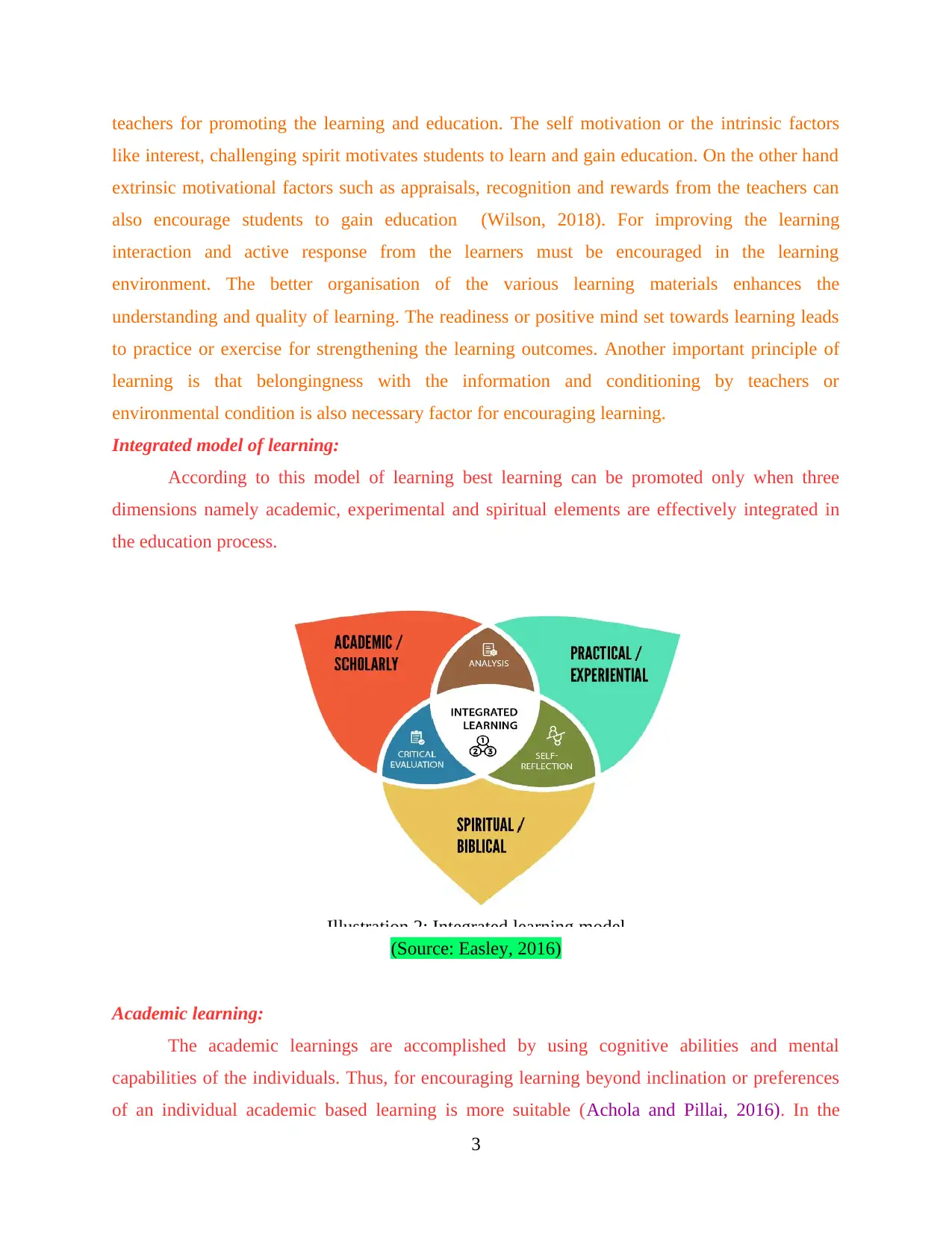
teachers for promoting the learning and education. The self motivation or the intrinsic factors
like interest, challenging spirit motivates students to learn and gain education. On the other hand
extrinsic motivational factors such as appraisals, recognition and rewards from the teachers can
also encourage students to gain education (Wilson, 2018). For improving the learning
interaction and active response from the learners must be encouraged in the learning
environment. The better organisation of the various learning materials enhances the
understanding and quality of learning. The readiness or positive mind set towards learning leads
to practice or exercise for strengthening the learning outcomes. Another important principle of
learning is that belongingness with the information and conditioning by teachers or
environmental condition is also necessary factor for encouraging learning.
Integrated model of learning:
According to this model of learning best learning can be promoted only when three
dimensions namely academic, experimental and spiritual elements are effectively integrated in
the education process.
(Source: Easley, 2016)
Academic learning:
The academic learnings are accomplished by using cognitive abilities and mental
capabilities of the individuals. Thus, for encouraging learning beyond inclination or preferences
of an individual academic based learning is more suitable (Achola and Pillai, 2016). In the
3
Illustration 2: Integrated learning model
like interest, challenging spirit motivates students to learn and gain education. On the other hand
extrinsic motivational factors such as appraisals, recognition and rewards from the teachers can
also encourage students to gain education (Wilson, 2018). For improving the learning
interaction and active response from the learners must be encouraged in the learning
environment. The better organisation of the various learning materials enhances the
understanding and quality of learning. The readiness or positive mind set towards learning leads
to practice or exercise for strengthening the learning outcomes. Another important principle of
learning is that belongingness with the information and conditioning by teachers or
environmental condition is also necessary factor for encouraging learning.
Integrated model of learning:
According to this model of learning best learning can be promoted only when three
dimensions namely academic, experimental and spiritual elements are effectively integrated in
the education process.
(Source: Easley, 2016)
Academic learning:
The academic learnings are accomplished by using cognitive abilities and mental
capabilities of the individuals. Thus, for encouraging learning beyond inclination or preferences
of an individual academic based learning is more suitable (Achola and Pillai, 2016). In the
3
Illustration 2: Integrated learning model
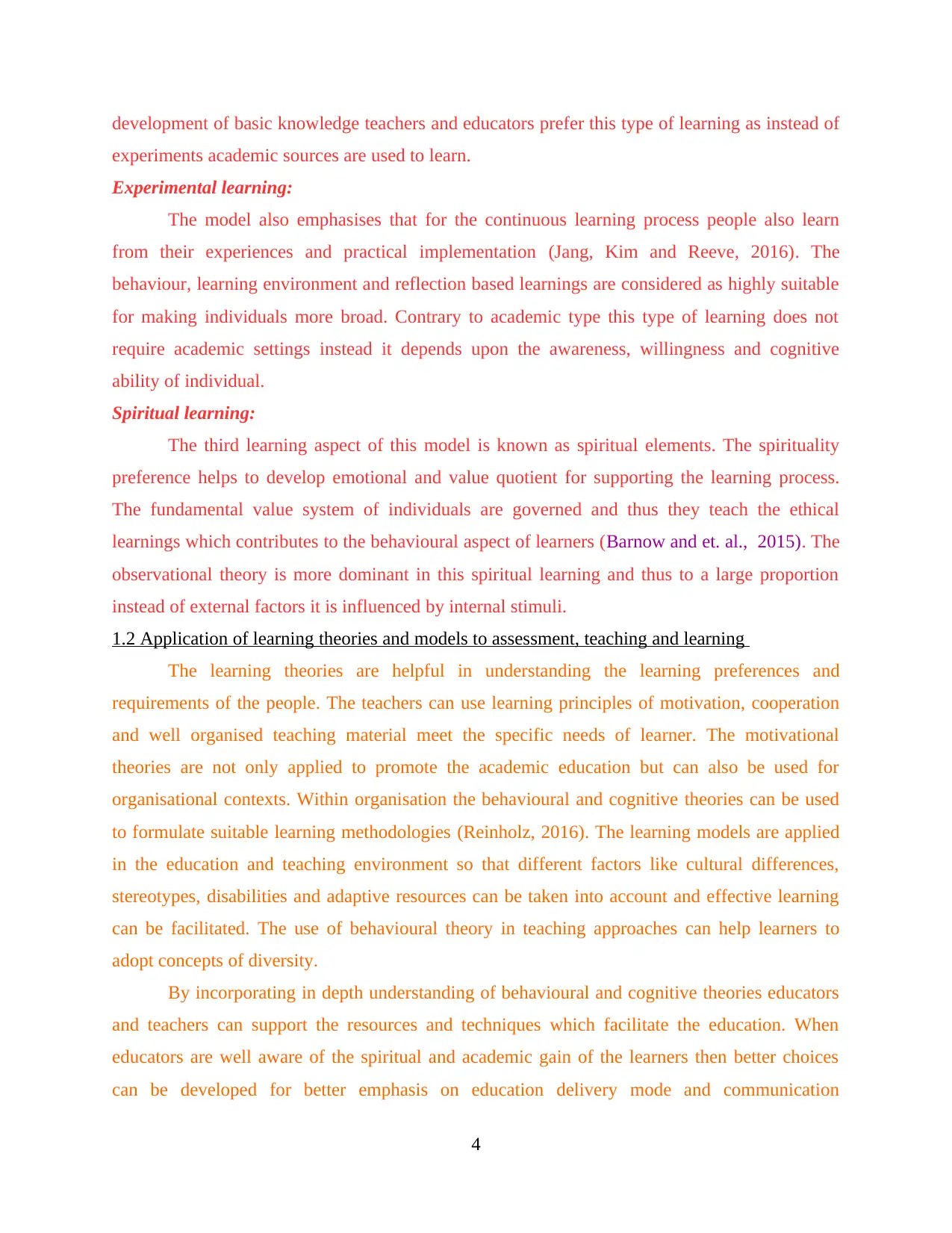
development of basic knowledge teachers and educators prefer this type of learning as instead of
experiments academic sources are used to learn.
Experimental learning:
The model also emphasises that for the continuous learning process people also learn
from their experiences and practical implementation (Jang, Kim and Reeve, 2016). The
behaviour, learning environment and reflection based learnings are considered as highly suitable
for making individuals more broad. Contrary to academic type this type of learning does not
require academic settings instead it depends upon the awareness, willingness and cognitive
ability of individual.
Spiritual learning:
The third learning aspect of this model is known as spiritual elements. The spirituality
preference helps to develop emotional and value quotient for supporting the learning process.
The fundamental value system of individuals are governed and thus they teach the ethical
learnings which contributes to the behavioural aspect of learners (Barnow and et. al., 2015). The
observational theory is more dominant in this spiritual learning and thus to a large proportion
instead of external factors it is influenced by internal stimuli.
1.2 Application of learning theories and models to assessment, teaching and learning
The learning theories are helpful in understanding the learning preferences and
requirements of the people. The teachers can use learning principles of motivation, cooperation
and well organised teaching material meet the specific needs of learner. The motivational
theories are not only applied to promote the academic education but can also be used for
organisational contexts. Within organisation the behavioural and cognitive theories can be used
to formulate suitable learning methodologies (Reinholz, 2016). The learning models are applied
in the education and teaching environment so that different factors like cultural differences,
stereotypes, disabilities and adaptive resources can be taken into account and effective learning
can be facilitated. The use of behavioural theory in teaching approaches can help learners to
adopt concepts of diversity.
By incorporating in depth understanding of behavioural and cognitive theories educators
and teachers can support the resources and techniques which facilitate the education. When
educators are well aware of the spiritual and academic gain of the learners then better choices
can be developed for better emphasis on education delivery mode and communication
4
experiments academic sources are used to learn.
Experimental learning:
The model also emphasises that for the continuous learning process people also learn
from their experiences and practical implementation (Jang, Kim and Reeve, 2016). The
behaviour, learning environment and reflection based learnings are considered as highly suitable
for making individuals more broad. Contrary to academic type this type of learning does not
require academic settings instead it depends upon the awareness, willingness and cognitive
ability of individual.
Spiritual learning:
The third learning aspect of this model is known as spiritual elements. The spirituality
preference helps to develop emotional and value quotient for supporting the learning process.
The fundamental value system of individuals are governed and thus they teach the ethical
learnings which contributes to the behavioural aspect of learners (Barnow and et. al., 2015). The
observational theory is more dominant in this spiritual learning and thus to a large proportion
instead of external factors it is influenced by internal stimuli.
1.2 Application of learning theories and models to assessment, teaching and learning
The learning theories are helpful in understanding the learning preferences and
requirements of the people. The teachers can use learning principles of motivation, cooperation
and well organised teaching material meet the specific needs of learner. The motivational
theories are not only applied to promote the academic education but can also be used for
organisational contexts. Within organisation the behavioural and cognitive theories can be used
to formulate suitable learning methodologies (Reinholz, 2016). The learning models are applied
in the education and teaching environment so that different factors like cultural differences,
stereotypes, disabilities and adaptive resources can be taken into account and effective learning
can be facilitated. The use of behavioural theory in teaching approaches can help learners to
adopt concepts of diversity.
By incorporating in depth understanding of behavioural and cognitive theories educators
and teachers can support the resources and techniques which facilitate the education. When
educators are well aware of the spiritual and academic gain of the learners then better choices
can be developed for better emphasis on education delivery mode and communication
4
⊘ This is a preview!⊘
Do you want full access?
Subscribe today to unlock all pages.

Trusted by 1+ million students worldwide
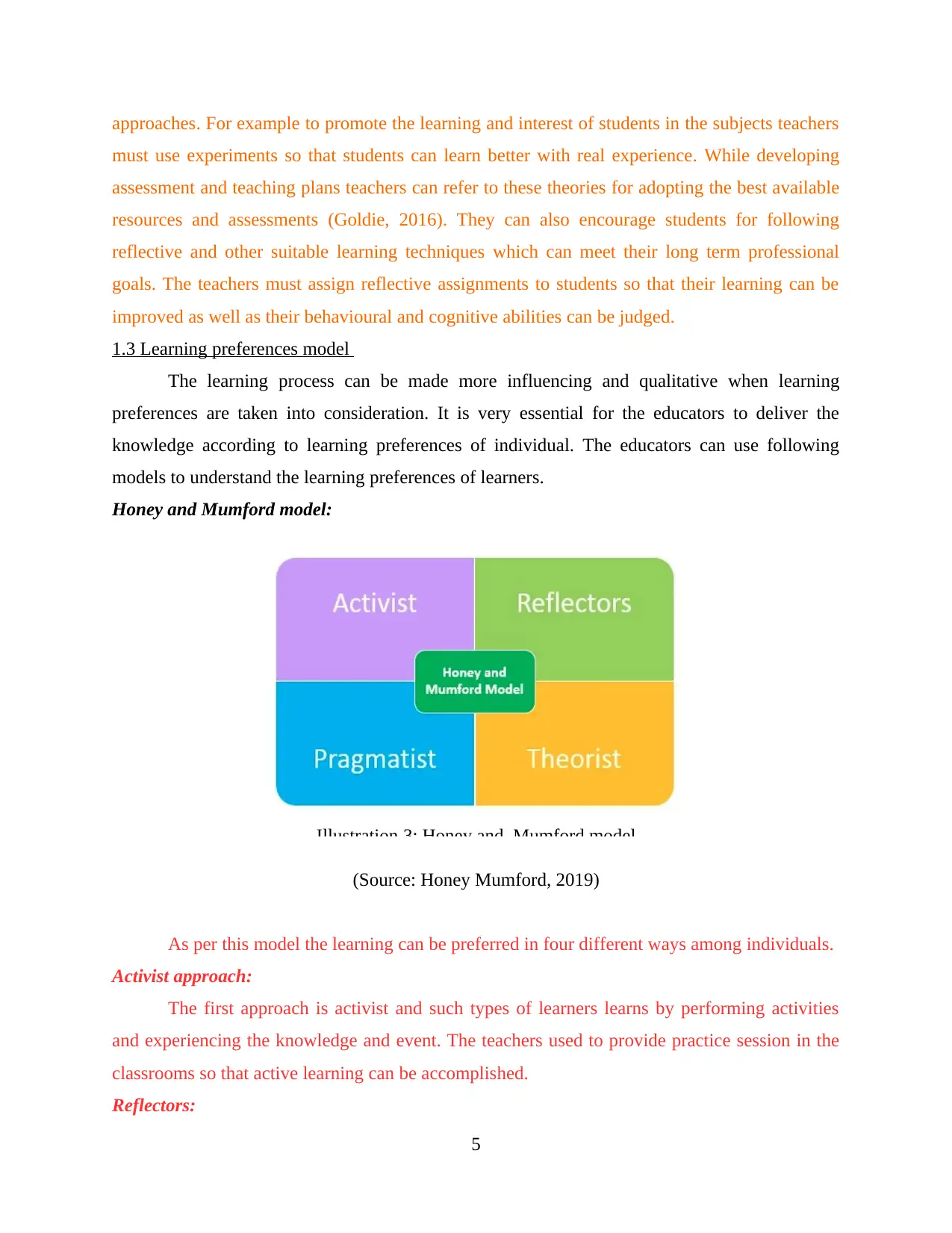
approaches. For example to promote the learning and interest of students in the subjects teachers
must use experiments so that students can learn better with real experience. While developing
assessment and teaching plans teachers can refer to these theories for adopting the best available
resources and assessments (Goldie, 2016). They can also encourage students for following
reflective and other suitable learning techniques which can meet their long term professional
goals. The teachers must assign reflective assignments to students so that their learning can be
improved as well as their behavioural and cognitive abilities can be judged.
1.3 Learning preferences model
The learning process can be made more influencing and qualitative when learning
preferences are taken into consideration. It is very essential for the educators to deliver the
knowledge according to learning preferences of individual. The educators can use following
models to understand the learning preferences of learners.
Honey and Mumford model:
(Source: Honey Mumford, 2019)
As per this model the learning can be preferred in four different ways among individuals.
Activist approach:
The first approach is activist and such types of learners learns by performing activities
and experiencing the knowledge and event. The teachers used to provide practice session in the
classrooms so that active learning can be accomplished.
Reflectors:
5
Illustration 3: Honey and Mumford model
must use experiments so that students can learn better with real experience. While developing
assessment and teaching plans teachers can refer to these theories for adopting the best available
resources and assessments (Goldie, 2016). They can also encourage students for following
reflective and other suitable learning techniques which can meet their long term professional
goals. The teachers must assign reflective assignments to students so that their learning can be
improved as well as their behavioural and cognitive abilities can be judged.
1.3 Learning preferences model
The learning process can be made more influencing and qualitative when learning
preferences are taken into consideration. It is very essential for the educators to deliver the
knowledge according to learning preferences of individual. The educators can use following
models to understand the learning preferences of learners.
Honey and Mumford model:
(Source: Honey Mumford, 2019)
As per this model the learning can be preferred in four different ways among individuals.
Activist approach:
The first approach is activist and such types of learners learns by performing activities
and experiencing the knowledge and event. The teachers used to provide practice session in the
classrooms so that active learning can be accomplished.
Reflectors:
5
Illustration 3: Honey and Mumford model
Paraphrase This Document
Need a fresh take? Get an instant paraphrase of this document with our AI Paraphraser
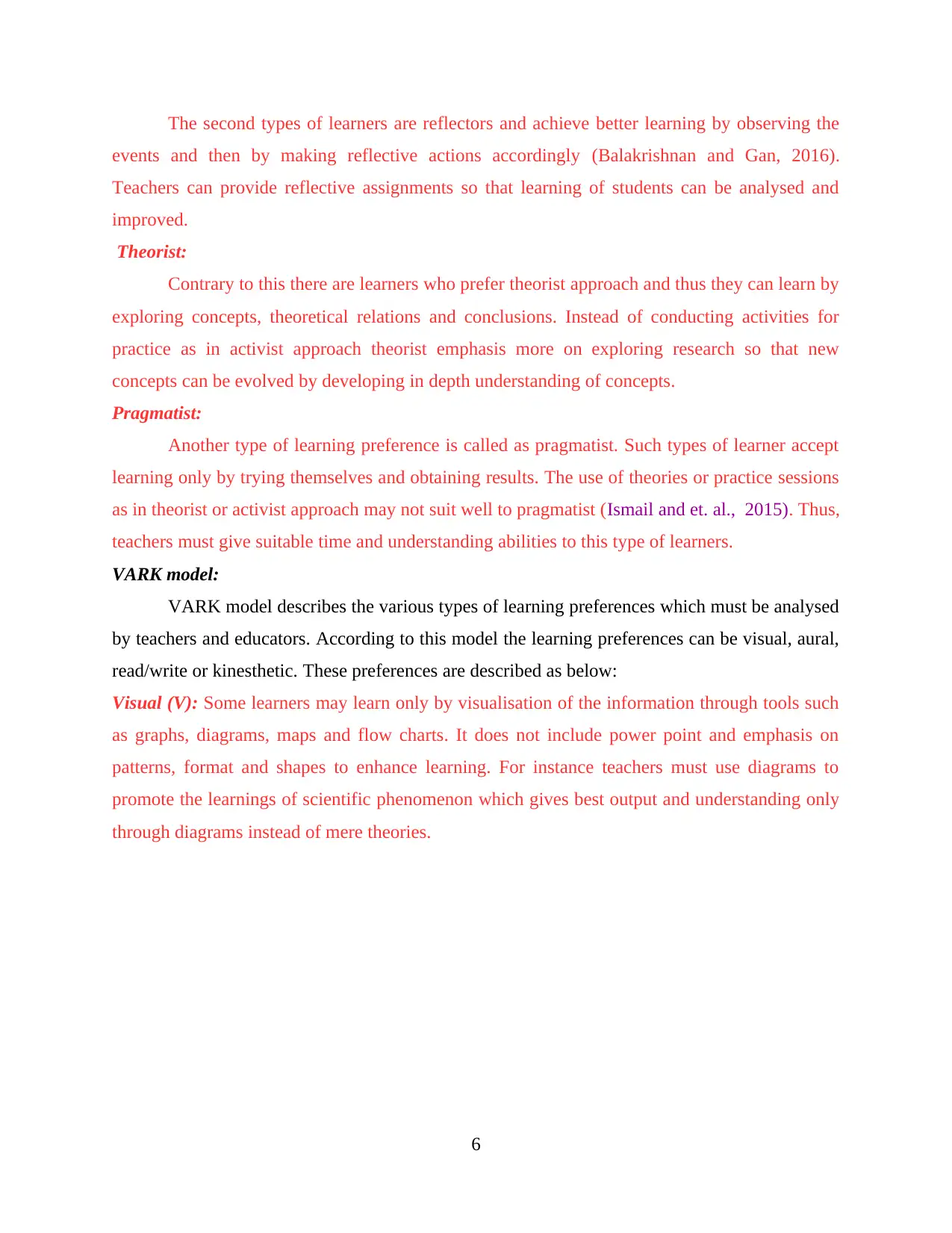
The second types of learners are reflectors and achieve better learning by observing the
events and then by making reflective actions accordingly (Balakrishnan and Gan, 2016).
Teachers can provide reflective assignments so that learning of students can be analysed and
improved.
Theorist:
Contrary to this there are learners who prefer theorist approach and thus they can learn by
exploring concepts, theoretical relations and conclusions. Instead of conducting activities for
practice as in activist approach theorist emphasis more on exploring research so that new
concepts can be evolved by developing in depth understanding of concepts.
Pragmatist:
Another type of learning preference is called as pragmatist. Such types of learner accept
learning only by trying themselves and obtaining results. The use of theories or practice sessions
as in theorist or activist approach may not suit well to pragmatist (Ismail and et. al., 2015). Thus,
teachers must give suitable time and understanding abilities to this type of learners.
VARK model:
VARK model describes the various types of learning preferences which must be analysed
by teachers and educators. According to this model the learning preferences can be visual, aural,
read/write or kinesthetic. These preferences are described as below:
Visual (V): Some learners may learn only by visualisation of the information through tools such
as graphs, diagrams, maps and flow charts. It does not include power point and emphasis on
patterns, format and shapes to enhance learning. For instance teachers must use diagrams to
promote the learnings of scientific phenomenon which gives best output and understanding only
through diagrams instead of mere theories.
6
events and then by making reflective actions accordingly (Balakrishnan and Gan, 2016).
Teachers can provide reflective assignments so that learning of students can be analysed and
improved.
Theorist:
Contrary to this there are learners who prefer theorist approach and thus they can learn by
exploring concepts, theoretical relations and conclusions. Instead of conducting activities for
practice as in activist approach theorist emphasis more on exploring research so that new
concepts can be evolved by developing in depth understanding of concepts.
Pragmatist:
Another type of learning preference is called as pragmatist. Such types of learner accept
learning only by trying themselves and obtaining results. The use of theories or practice sessions
as in theorist or activist approach may not suit well to pragmatist (Ismail and et. al., 2015). Thus,
teachers must give suitable time and understanding abilities to this type of learners.
VARK model:
VARK model describes the various types of learning preferences which must be analysed
by teachers and educators. According to this model the learning preferences can be visual, aural,
read/write or kinesthetic. These preferences are described as below:
Visual (V): Some learners may learn only by visualisation of the information through tools such
as graphs, diagrams, maps and flow charts. It does not include power point and emphasis on
patterns, format and shapes to enhance learning. For instance teachers must use diagrams to
promote the learnings of scientific phenomenon which gives best output and understanding only
through diagrams instead of mere theories.
6
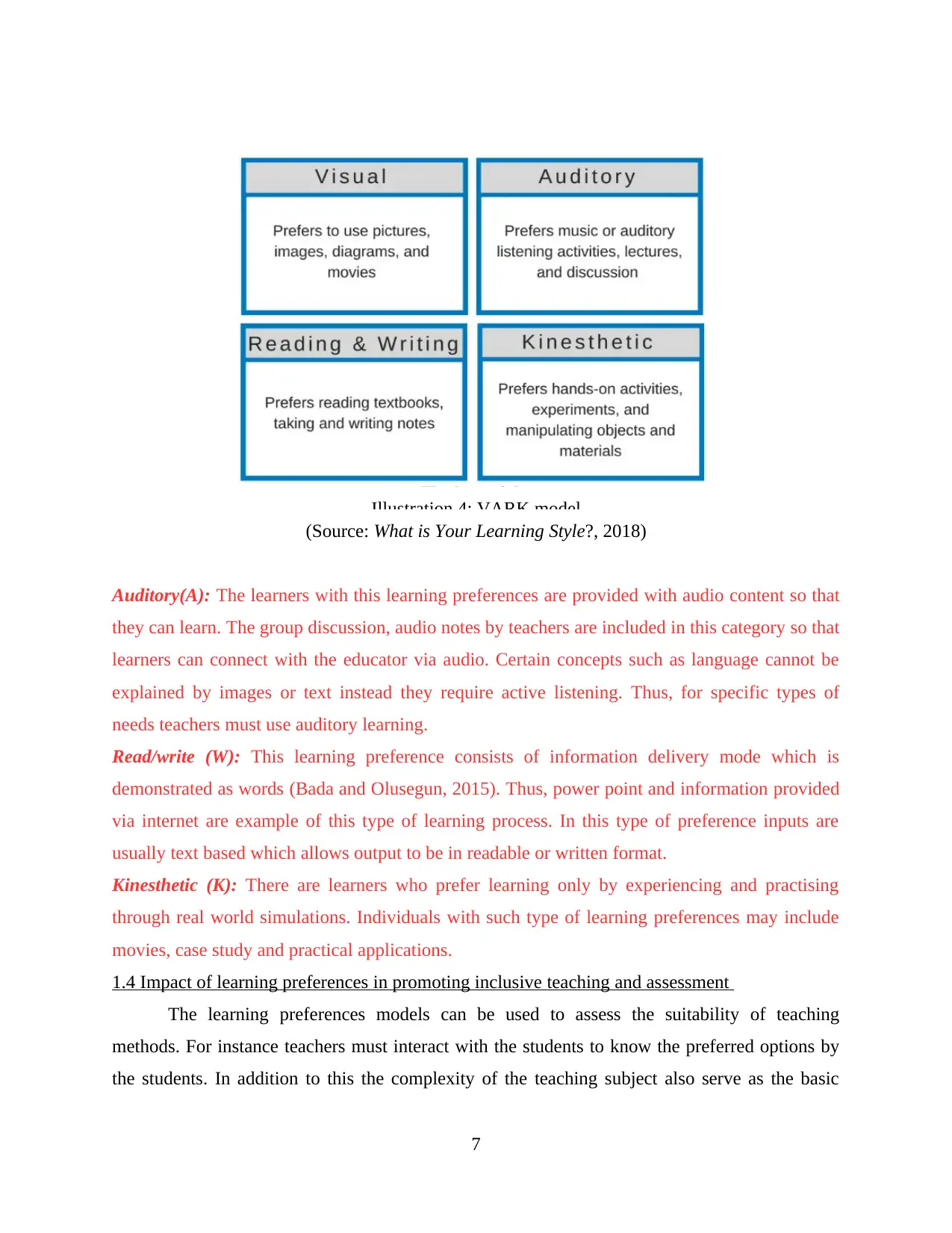
(Source: What is Your Learning Style?, 2018)
Auditory(A): The learners with this learning preferences are provided with audio content so that
they can learn. The group discussion, audio notes by teachers are included in this category so that
learners can connect with the educator via audio. Certain concepts such as language cannot be
explained by images or text instead they require active listening. Thus, for specific types of
needs teachers must use auditory learning.
Read/write (W): This learning preference consists of information delivery mode which is
demonstrated as words (Bada and Olusegun, 2015). Thus, power point and information provided
via internet are example of this type of learning process. In this type of preference inputs are
usually text based which allows output to be in readable or written format.
Kinesthetic (K): There are learners who prefer learning only by experiencing and practising
through real world simulations. Individuals with such type of learning preferences may include
movies, case study and practical applications.
1.4 Impact of learning preferences in promoting inclusive teaching and assessment
The learning preferences models can be used to assess the suitability of teaching
methods. For instance teachers must interact with the students to know the preferred options by
the students. In addition to this the complexity of the teaching subject also serve as the basic
7
Illustration 4: VARK model
Auditory(A): The learners with this learning preferences are provided with audio content so that
they can learn. The group discussion, audio notes by teachers are included in this category so that
learners can connect with the educator via audio. Certain concepts such as language cannot be
explained by images or text instead they require active listening. Thus, for specific types of
needs teachers must use auditory learning.
Read/write (W): This learning preference consists of information delivery mode which is
demonstrated as words (Bada and Olusegun, 2015). Thus, power point and information provided
via internet are example of this type of learning process. In this type of preference inputs are
usually text based which allows output to be in readable or written format.
Kinesthetic (K): There are learners who prefer learning only by experiencing and practising
through real world simulations. Individuals with such type of learning preferences may include
movies, case study and practical applications.
1.4 Impact of learning preferences in promoting inclusive teaching and assessment
The learning preferences models can be used to assess the suitability of teaching
methods. For instance teachers must interact with the students to know the preferred options by
the students. In addition to this the complexity of the teaching subject also serve as the basic
7
Illustration 4: VARK model
⊘ This is a preview!⊘
Do you want full access?
Subscribe today to unlock all pages.

Trusted by 1+ million students worldwide
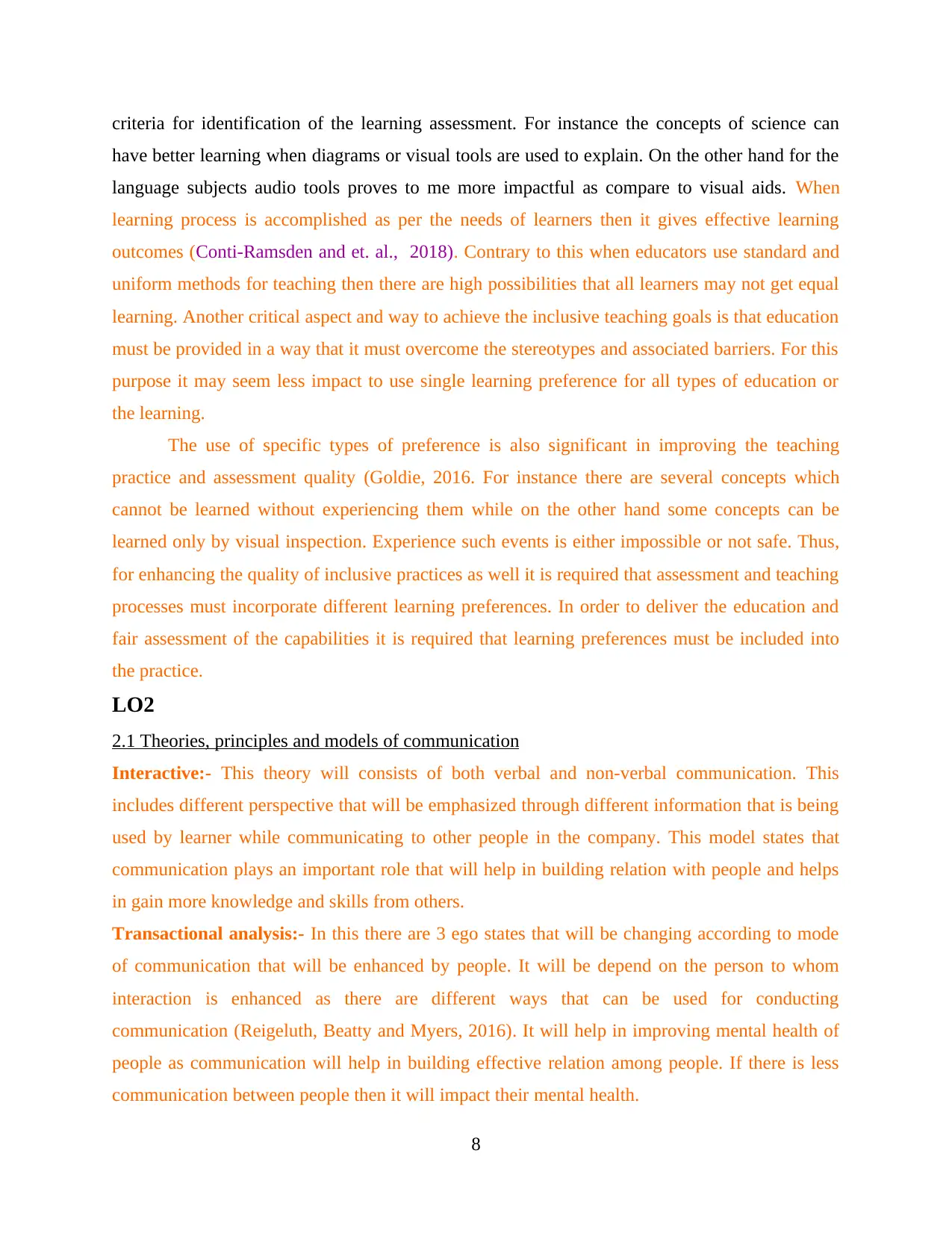
criteria for identification of the learning assessment. For instance the concepts of science can
have better learning when diagrams or visual tools are used to explain. On the other hand for the
language subjects audio tools proves to me more impactful as compare to visual aids. When
learning process is accomplished as per the needs of learners then it gives effective learning
outcomes (Conti‐Ramsden and et. al., 2018). Contrary to this when educators use standard and
uniform methods for teaching then there are high possibilities that all learners may not get equal
learning. Another critical aspect and way to achieve the inclusive teaching goals is that education
must be provided in a way that it must overcome the stereotypes and associated barriers. For this
purpose it may seem less impact to use single learning preference for all types of education or
the learning.
The use of specific types of preference is also significant in improving the teaching
practice and assessment quality (Goldie, 2016. For instance there are several concepts which
cannot be learned without experiencing them while on the other hand some concepts can be
learned only by visual inspection. Experience such events is either impossible or not safe. Thus,
for enhancing the quality of inclusive practices as well it is required that assessment and teaching
processes must incorporate different learning preferences. In order to deliver the education and
fair assessment of the capabilities it is required that learning preferences must be included into
the practice.
LO2
2.1 Theories, principles and models of communication
Interactive:- This theory will consists of both verbal and non-verbal communication. This
includes different perspective that will be emphasized through different information that is being
used by learner while communicating to other people in the company. This model states that
communication plays an important role that will help in building relation with people and helps
in gain more knowledge and skills from others.
Transactional analysis:- In this there are 3 ego states that will be changing according to mode
of communication that will be enhanced by people. It will be depend on the person to whom
interaction is enhanced as there are different ways that can be used for conducting
communication (Reigeluth, Beatty and Myers, 2016). It will help in improving mental health of
people as communication will help in building effective relation among people. If there is less
communication between people then it will impact their mental health.
8
have better learning when diagrams or visual tools are used to explain. On the other hand for the
language subjects audio tools proves to me more impactful as compare to visual aids. When
learning process is accomplished as per the needs of learners then it gives effective learning
outcomes (Conti‐Ramsden and et. al., 2018). Contrary to this when educators use standard and
uniform methods for teaching then there are high possibilities that all learners may not get equal
learning. Another critical aspect and way to achieve the inclusive teaching goals is that education
must be provided in a way that it must overcome the stereotypes and associated barriers. For this
purpose it may seem less impact to use single learning preference for all types of education or
the learning.
The use of specific types of preference is also significant in improving the teaching
practice and assessment quality (Goldie, 2016. For instance there are several concepts which
cannot be learned without experiencing them while on the other hand some concepts can be
learned only by visual inspection. Experience such events is either impossible or not safe. Thus,
for enhancing the quality of inclusive practices as well it is required that assessment and teaching
processes must incorporate different learning preferences. In order to deliver the education and
fair assessment of the capabilities it is required that learning preferences must be included into
the practice.
LO2
2.1 Theories, principles and models of communication
Interactive:- This theory will consists of both verbal and non-verbal communication. This
includes different perspective that will be emphasized through different information that is being
used by learner while communicating to other people in the company. This model states that
communication plays an important role that will help in building relation with people and helps
in gain more knowledge and skills from others.
Transactional analysis:- In this there are 3 ego states that will be changing according to mode
of communication that will be enhanced by people. It will be depend on the person to whom
interaction is enhanced as there are different ways that can be used for conducting
communication (Reigeluth, Beatty and Myers, 2016). It will help in improving mental health of
people as communication will help in building effective relation among people. If there is less
communication between people then it will impact their mental health.
8
Paraphrase This Document
Need a fresh take? Get an instant paraphrase of this document with our AI Paraphraser
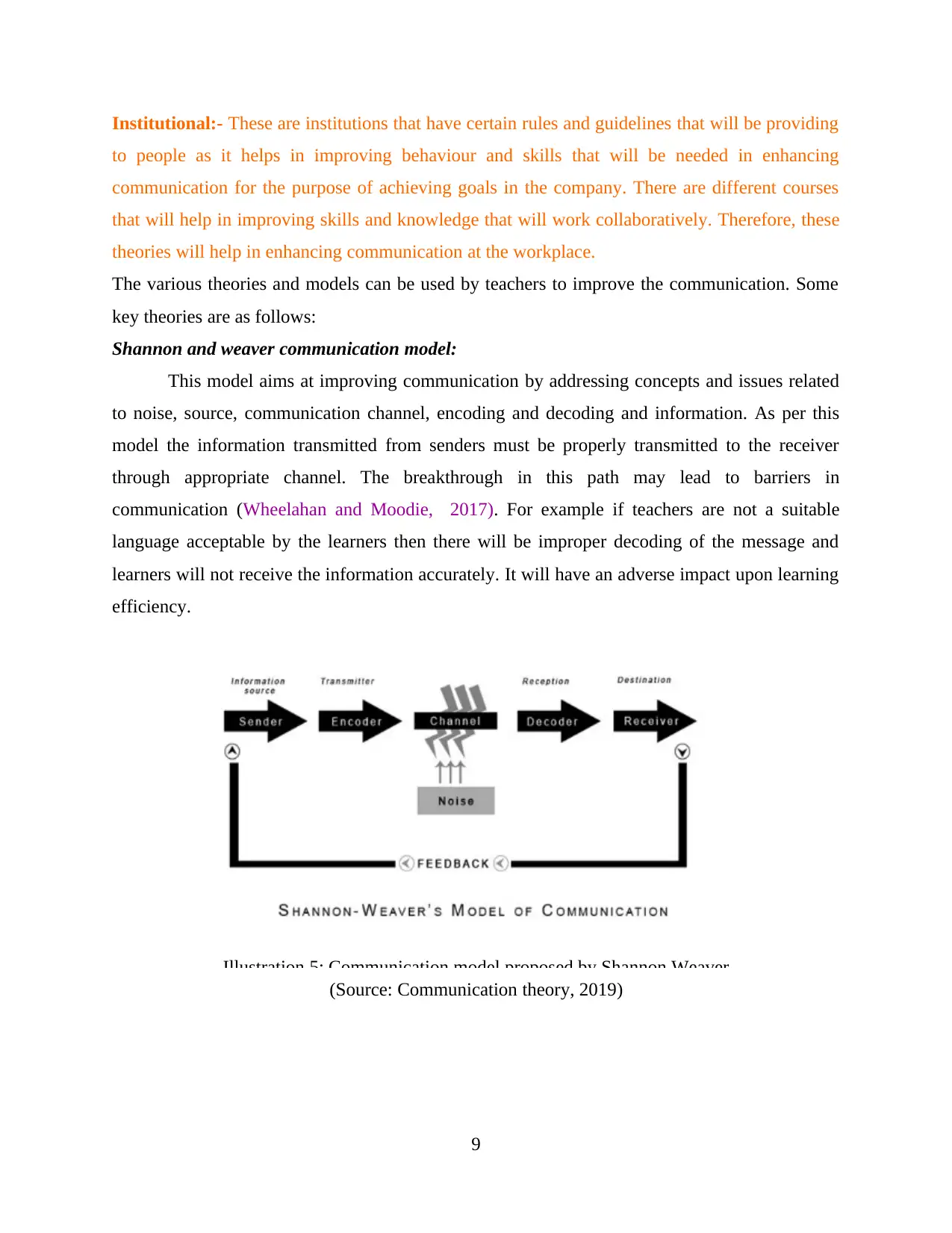
Institutional:- These are institutions that have certain rules and guidelines that will be providing
to people as it helps in improving behaviour and skills that will be needed in enhancing
communication for the purpose of achieving goals in the company. There are different courses
that will help in improving skills and knowledge that will work collaboratively. Therefore, these
theories will help in enhancing communication at the workplace.
The various theories and models can be used by teachers to improve the communication. Some
key theories are as follows:
Shannon and weaver communication model:
This model aims at improving communication by addressing concepts and issues related
to noise, source, communication channel, encoding and decoding and information. As per this
model the information transmitted from senders must be properly transmitted to the receiver
through appropriate channel. The breakthrough in this path may lead to barriers in
communication (Wheelahan and Moodie, 2017). For example if teachers are not a suitable
language acceptable by the learners then there will be improper decoding of the message and
learners will not receive the information accurately. It will have an adverse impact upon learning
efficiency.
(Source: Communication theory, 2019)
9
Illustration 5: Communication model proposed by Shannon Weaver
to people as it helps in improving behaviour and skills that will be needed in enhancing
communication for the purpose of achieving goals in the company. There are different courses
that will help in improving skills and knowledge that will work collaboratively. Therefore, these
theories will help in enhancing communication at the workplace.
The various theories and models can be used by teachers to improve the communication. Some
key theories are as follows:
Shannon and weaver communication model:
This model aims at improving communication by addressing concepts and issues related
to noise, source, communication channel, encoding and decoding and information. As per this
model the information transmitted from senders must be properly transmitted to the receiver
through appropriate channel. The breakthrough in this path may lead to barriers in
communication (Wheelahan and Moodie, 2017). For example if teachers are not a suitable
language acceptable by the learners then there will be improper decoding of the message and
learners will not receive the information accurately. It will have an adverse impact upon learning
efficiency.
(Source: Communication theory, 2019)
9
Illustration 5: Communication model proposed by Shannon Weaver
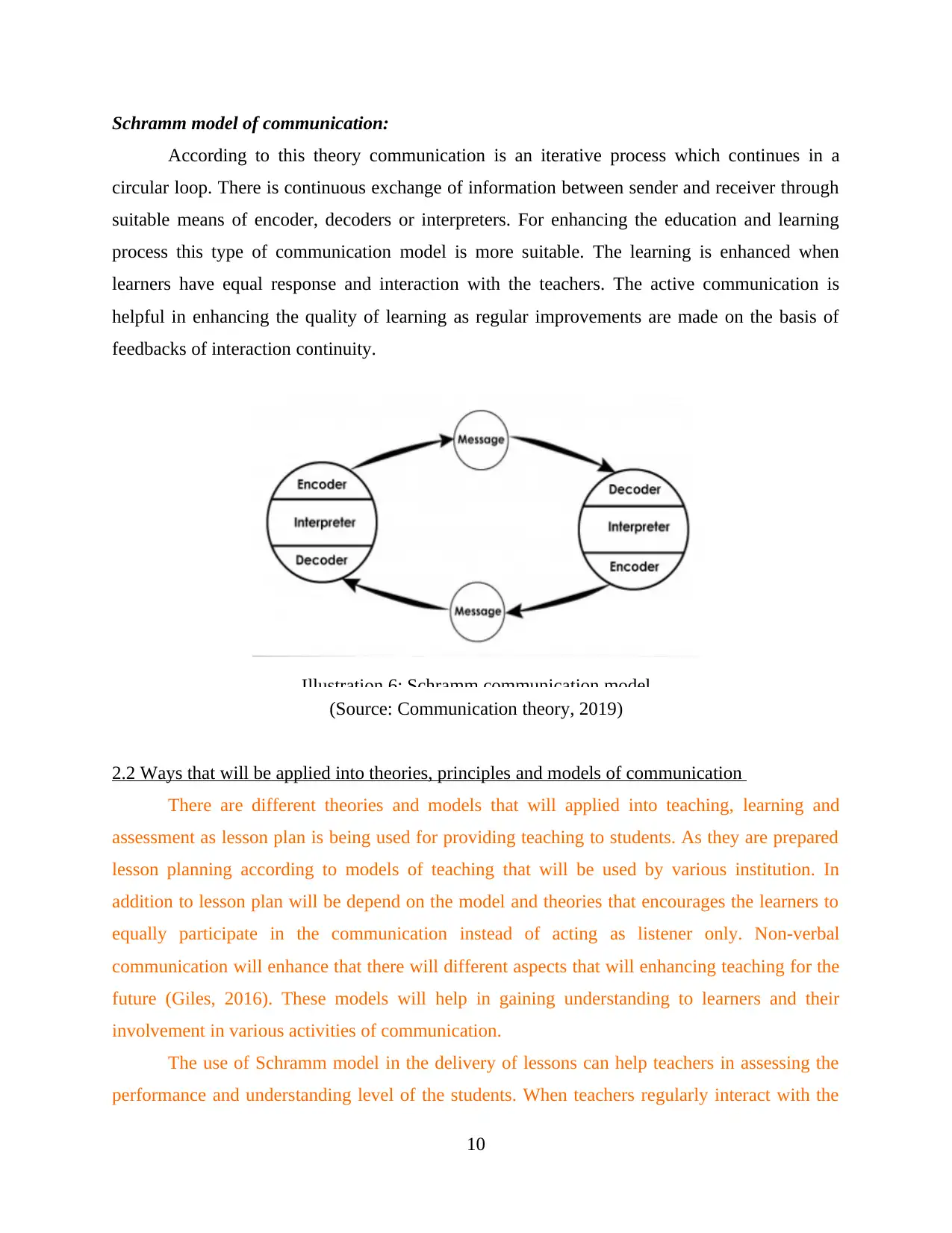
Schramm model of communication:
According to this theory communication is an iterative process which continues in a
circular loop. There is continuous exchange of information between sender and receiver through
suitable means of encoder, decoders or interpreters. For enhancing the education and learning
process this type of communication model is more suitable. The learning is enhanced when
learners have equal response and interaction with the teachers. The active communication is
helpful in enhancing the quality of learning as regular improvements are made on the basis of
feedbacks of interaction continuity.
(Source: Communication theory, 2019)
2.2 Ways that will be applied into theories, principles and models of communication
There are different theories and models that will applied into teaching, learning and
assessment as lesson plan is being used for providing teaching to students. As they are prepared
lesson planning according to models of teaching that will be used by various institution. In
addition to lesson plan will be depend on the model and theories that encourages the learners to
equally participate in the communication instead of acting as listener only. Non-verbal
communication will enhance that there will different aspects that will enhancing teaching for the
future (Giles, 2016). These models will help in gaining understanding to learners and their
involvement in various activities of communication.
The use of Schramm model in the delivery of lessons can help teachers in assessing the
performance and understanding level of the students. When teachers regularly interact with the
10
Illustration 6: Schramm communication model
According to this theory communication is an iterative process which continues in a
circular loop. There is continuous exchange of information between sender and receiver through
suitable means of encoder, decoders or interpreters. For enhancing the education and learning
process this type of communication model is more suitable. The learning is enhanced when
learners have equal response and interaction with the teachers. The active communication is
helpful in enhancing the quality of learning as regular improvements are made on the basis of
feedbacks of interaction continuity.
(Source: Communication theory, 2019)
2.2 Ways that will be applied into theories, principles and models of communication
There are different theories and models that will applied into teaching, learning and
assessment as lesson plan is being used for providing teaching to students. As they are prepared
lesson planning according to models of teaching that will be used by various institution. In
addition to lesson plan will be depend on the model and theories that encourages the learners to
equally participate in the communication instead of acting as listener only. Non-verbal
communication will enhance that there will different aspects that will enhancing teaching for the
future (Giles, 2016). These models will help in gaining understanding to learners and their
involvement in various activities of communication.
The use of Schramm model in the delivery of lessons can help teachers in assessing the
performance and understanding level of the students. When teachers regularly interact with the
10
Illustration 6: Schramm communication model
⊘ This is a preview!⊘
Do you want full access?
Subscribe today to unlock all pages.

Trusted by 1+ million students worldwide
1 out of 27
Related Documents
Your All-in-One AI-Powered Toolkit for Academic Success.
+13062052269
info@desklib.com
Available 24*7 on WhatsApp / Email
![[object Object]](/_next/static/media/star-bottom.7253800d.svg)
Unlock your academic potential
Copyright © 2020–2025 A2Z Services. All Rights Reserved. Developed and managed by ZUCOL.


